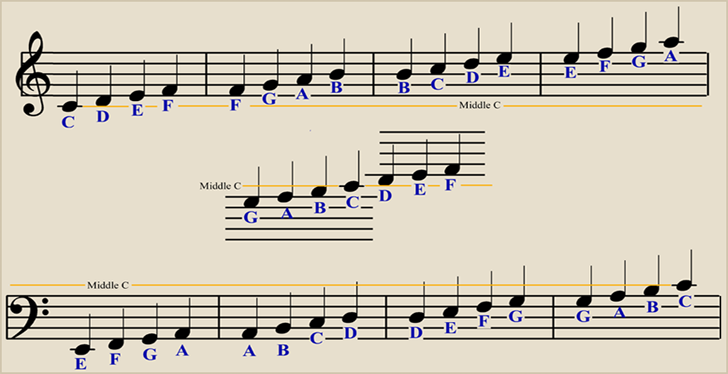Music Theory
Music theory is a field of study that deals with the how and why of music. How music is written and played, based on certain mathematical principals, and why
these mathematical principals form the basis of all musical
compositions. Pythagoras is generally considered to be the creator of
these math based rules which came about more as a need to standardize
the composition of music, as well as the design and construction of the
instruments of the time period. We should also note that while these
tenets are firmly rooted in what is commonly accepted as, "harmonious
sound patterns", it should remain obvious, by the shear volume of
musical compositions, that the theory, (mathematics), of music is more a
means of defining than limiting the creative process.
Music Theory, while not an absolute requirement for playing music, is a "plus" in understanding music, and a definite "must" if you wish to advance your musical abilities . The aspiring musician should at least have some knowledge of basic music theory, as playing music and learning music are not quite the same. Music theory is learning the language of music, as well as the concepts of music, and understanding music theory will enable you to "sit in" with any musician, with any style/genre, and play/speak the language of music with some authority. Learning music, or at least some basic music theory will certainly do no harm and will open the door to a better understanding of music, and increase your versatiliy as a musician.
Music Theory, while not an absolute requirement for playing music, is a "plus" in understanding music, and a definite "must" if you wish to advance your musical abilities . The aspiring musician should at least have some knowledge of basic music theory, as playing music and learning music are not quite the same. Music theory is learning the language of music, as well as the concepts of music, and understanding music theory will enable you to "sit in" with any musician, with any style/genre, and play/speak the language of music with some authority. Learning music, or at least some basic music theory will certainly do no harm and will open the door to a better understanding of music, and increase your versatiliy as a musician.
The Music Staff

Staff Components
The music staff has two main components, one being
the treble staff, and the other being the bass staff. The treble staff
is designated by the "G, or Treble Clef", and the bass by the "F, or Bass Clef". These two staffs come together at a common note "Middle C". Middle C is the division point on the piano between the bass and the treble notes. Notes below Middle C,
(bass), are usually played with the left hand, while those above Middle
C, (treble), are played with the right hand. The music staffs are
divided by Middle C, with the treble staff being above and the bass
staff being underneath. If we extend the ledger lines
that pass through the notes that appear below the treble staff, or
above the bass staff, we can see the continuation of the music scale,
from the bass staff on up through the treble staff.
In the diagram below the upper staff
is the treble staff denoted by the "G Clef", the bottom is the bass
staff denoted by the "F Clef" . The middle image shows the progression
of the notes from the bass to the treble as they pass through "Middle
C", (gold line).

Mnemonics are sometimes used to
assist in remembering where the notes are located on the staff. The more
commonly accepted mnemonics are shown below.

Treble and Bass Clef Note Relationship
Six String Guitar (top) - 4 String Bass (bottom)

Piano Keyboard

The Black Keys are for Sharps and Flats. Note that the intervals from B to C and from E to F are only a Half step, so there is no need for a Black Key between them.
Though the treble and bass clefs are the most
commonly used in music composition, they are not the only clefs used
for notation. Other frequently seen clefs are:

The need for a variety of clefs, (especially movable
clefs), becomes apparent when we realize that not all instruments
"play" in the same pitch range. Since the music staff has only 5 lines
it would be difficult to write orchestrations for a large group of
instruments without being able to designate the individual pitch ranges
on the staff.
C clef (Alto Clef and Tenor Clef)
This clef points to the line representing middle C. Positioned here, it makes the center line on the staff middle C, and is referred to as the "alto clef." This clef is used in modern notation for the viola. While all clefs can be placed anywhere on the staff to indicate pich range, the C clef is most often considered a "movable" clef: it is frequently seen pointing instead to the fourth line and called a "tenor clef". This clef is used very often in music written for bassoon, cello, and trombone; it replaces the bass clef when the number of ledger lines above the bass staff hinders easy reading.
Neutral clef.

Used for pitchless instruments, such as those used
for percussion. Each line can represent a specific percussion instrument
within a set, such as in a drum set. . It may also be drawn with a
separate single-line staff for each untuned percussion instrument.


Aucun commentaire:
Enregistrer un commentaire